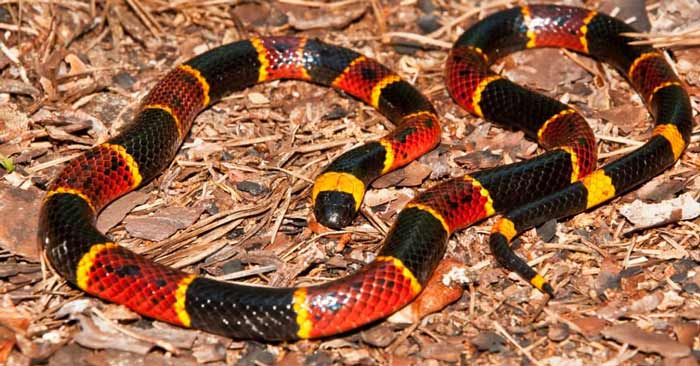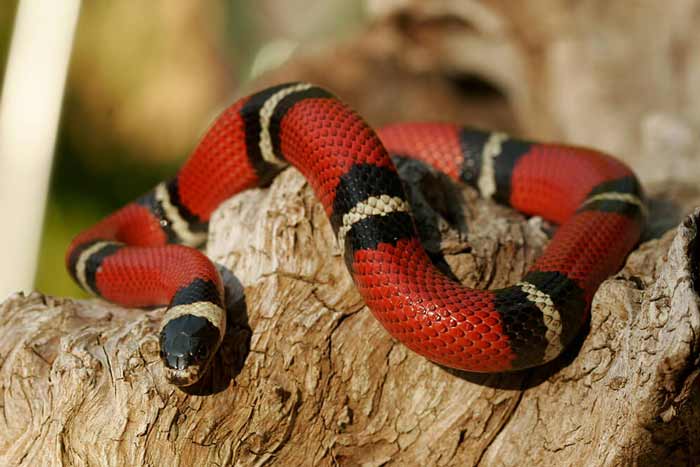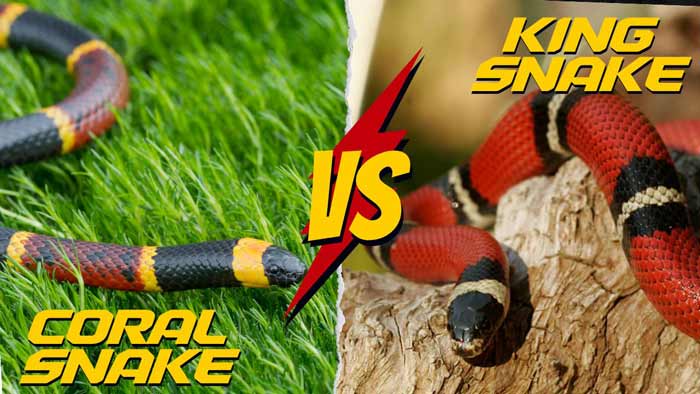The coral snake and the king snake are often subjects of confusion due to their strikingly similar appearances. However, these two species are distinctly different in many aspects, including venom potency, behavior, habitat, and diet.
This detailed comparison aims to explore these differences, offering a clear understanding of each species.
Quick Overview
| Coral Snake | King Snake | |
|---|---|---|
| Size | Typically 18 to 20 inches, can reach up to 48 inches | Averages 16-20 inches in length |
| Color Pattern | Red and yellow bands touch | Red and black bands touch |
| Habitat | Forested areas, underground burrows or under leaves | Forests, grasslands, shrublands, deserts |
| Venom | Venomous, neurotoxic venom | Non-venomous |
| Diet | Frogs, lizards, other snakes | Lizards, snakes, small mammals |
| Behavior | Reclusive and elusive, avoids confrontation | Active, can be aggressive when threatened |
| Lifespan | Average about 7 years in the wild | Typically 20 to 30 years |
Color
Coral snakes and king snakes both exhibit a colorful pattern of red, black, and yellow bands, but the arrangement of these colors is key to their identification.

Coral snakes have a pattern where the red and yellow bands touch, signaling their venomous nature. The mnemonic “Red touch yellow, kill a fellow” helps in identifying these dangerous snakes.

In contrast, king snakes, particularly the scarlet king snake, display a pattern where the red and black bands touch. The saying “Red touch black, venom lack” is a useful guide to distinguish these non-venomous mimics.
Size
Coral snakes and king snakes have overlapping sizes but with notable differences. Coral snakes typically measure 18 to 20 inches in length, with some species like the Texas coral snake reaching up to 48 inches.
On the other hand, king snakes, such as the scarlet king snake, are generally smaller, averaging 16-20 inches in length.
Habitat

The habitat preferences of coral snakes and king snakes vary distinctly. Coral snakes are often found in forested areas, preferring to burrow underground or beneath leaves. They are primarily located in the southern half of the U.S. and northern Mexico.
King snakes have a broader habitat range, including forests, grasslands, shrublands, and deserts across North America, showcasing their adaptability to different environments.
Venom
The difference in venom between coral snakes and king snakes is significant. Coral snakes are venomous, possessing neurotoxic venom that can be life-threatening.
In contrast, king snakes are non-venomous and pose no venomous threat to humans.
Diet
Coral snakes and king snakes have different diets and hunting methods. Coral snakes feed on frogs, lizards, and other snakes, using their venom to paralyze and subdue their prey.
King snakes, being constrictors, primarily consume lizards, snakes, and small mammals, using constriction to subdue their prey.
Behavior
In terms of behavior, coral snakes are more reclusive and elusive, often avoiding confrontation. King snakes are known for being more active and can be aggressive when threatened, displaying a more assertive presence in their environment.
Lifespan
The lifespan of these two snake species also differs. Coral snakes have a shorter average lifespan of about 7 years in the wild.
In contrast, king snakes typically enjoy a longer lifespan, ranging from 20 to 30 years, reflecting their adaptability and resilience in various environments.
Conclusion
Understanding the differences between coral snakes and king snakes is crucial for both safety and wildlife appreciation. While they may appear similar, their venom, behavior, diet, and habitat set them apart significantly. Both species play important roles in their respective ecosystems, contributing to the biodiversity and ecological balance of their habitats.
FAQs
The key difference is in their color pattern. Coral snakes have red and yellow bands that touch, while king snakes have red and black bands that touch.
Yes, coral snakes are venomous and have neurotoxic venom, making them more dangerous. King snakes are non-venomous and pose no venomous threat to humans.
Coral snakes are often found in forested areas, preferring underground burrows or beneath leaves. King snakes inhabit a variety of environments, including forests, grasslands, shrublands, and deserts.
Yes, king snakes are known to prey on other snakes, including venomous species like coral snakes, due to their immunity to snake venom.
Coral snakes have a shorter lifespan, averaging about 7 years in the wild, while king snakes can live for 20 to 30 years.
The color patterns serve as a warning in coral snakes, indicating their venomous nature. In king snakes, the similar pattern is a form of Batesian mimicry, deterring predators by imitating the venomous coral snake.




